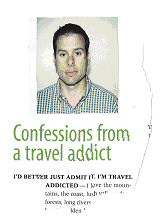Namibia Up Close and Slightly Personal
 December 23, 2006
December 23, 2006If you find yourself searching for a map when you hear of Namibia, you’re not alone. Tucked away on the lower southwest coast of Africa, between the Atlantic Ocean in the West, Angola in the North, South Africa to the south and Botswana to the East, Namibia is one of the most sparsely populated countries on the planet with a population of an estimated 1.87 million.
Achieving independence in March 1990 after 106 years of German colonialism, Namibia is a burgeoning democracy with a constitution structured similar to that of the United States. The President serves a five year term and Parliament is comprised of two houses, one elected directly by the people and the other indirectly by the country’s regional states.
Despite its democratic strides, the people of Namibia are still recovering from decades of apartheid. Segregation is still noticeable even to the casual visitor. Signs can be seen at restaurants, shopping malls and driving through neighborhoods. Before my arrival, I was unaware of the significant role apartheid played in the country, but as it turns out, black Namibians suffered much like those in South Africa, Namibia having formerly been run by a “governor” operating under the auspices of the South African government.
Architecturally, Windhoek, the capital of Namibia, reminds me of what downtown Stockton might have looked like in the late ‘60s, early ‘70s. Security in the capital is everywhere. When you park your car, there is a man with a semi-official looking blue vest that reads, “Crime Prevention”. These are the guys that watch your car while you’re parked at a meter to make sure no one breaks in. When you return to your car, you typically pay them a few Namibian dollars for their services. In the malls, security guards check your bags into and out of many stores. Private security in Windhoek is big business.
 (Downtown Windhoek)
(Downtown Windhoek)Many of the homes, including the pension at which I stayed, have electric wires on top of the cinder block walls surrounding their homes/compounds. There is usually a security gate to many stores on the street into which you must be buzzed to enter and exit, with merchandise far less expensive than that of Tiffanys.
My arrival a few days before Christmas lent itself to an entirely different holiday experience. Instead of “frightful weather” outside, it was 85 degrees and sunny. Santa Claus was a recluse and Jingle Bells and Rudolph were on strike. Still, with 90 percent of the population practicing some form of Christianity, Christmas is the biggest national holiday of the year. Shops close for several days and there is the usual hustle and bustle in the days preceding the actual holiday. However, unlike the last minute shopping that is available in the U.S., shops in Namibia close very early on the day before Christmas Eve. Moreover, most of the shopping for gifts is actually the purchase of new clothes for the kids as opposed to the toy component to Christmas in the U.S..
From my room at the pension, fan whirling above my head as the only cooling source from the hot dry desert wind, Christmas seemed out of place. Namibia is the most arid country in Southern Africa with a humidity of less than 10 percent during the winter months and 50-80 percent in the summer. Afternoon thunderstorms passed over each of my days in Windhoek, which made napping off my unusually heavy jet lag more palatable in my own mind.
Rich in resources, both above and below ground, Namibia is taking aggressive steps to preserve its natural resources. It was the first country in the world to include the protection of the environment in its constitution, providing that at least 10 percent of the country’s surface be set aside for conservation purposes. It is the world’s fifth largest diamond supplier and many other gemstones, most notably tourmalines.
Unfortunately, Namibia is one of the hardest hit countries for HIV/AIDS in Africa. Recent surveys show that 20-23% of pregnant women were found HIV positive. In some regions the rate of infection is as high as 45-46%. But as Namibia makes large strides to harness its resources, development of hospitals and purchase of modern medical equipment is made possible with a growing GDP, of which tourism has only 14%. Plans to cater the upscale safari tourist are well along as upscale lodges throughout the country charge tariffs of $350-$500 per night.
If you’re into self-drive safaris (Etosha Park) with the Big 5 (Lion, Rhino, Elephant, Cheetah and Leopard), beautiful sand dunes (more on them later) and a dry desert climate, then Namibia is a destination well worth the trip.


<< Home